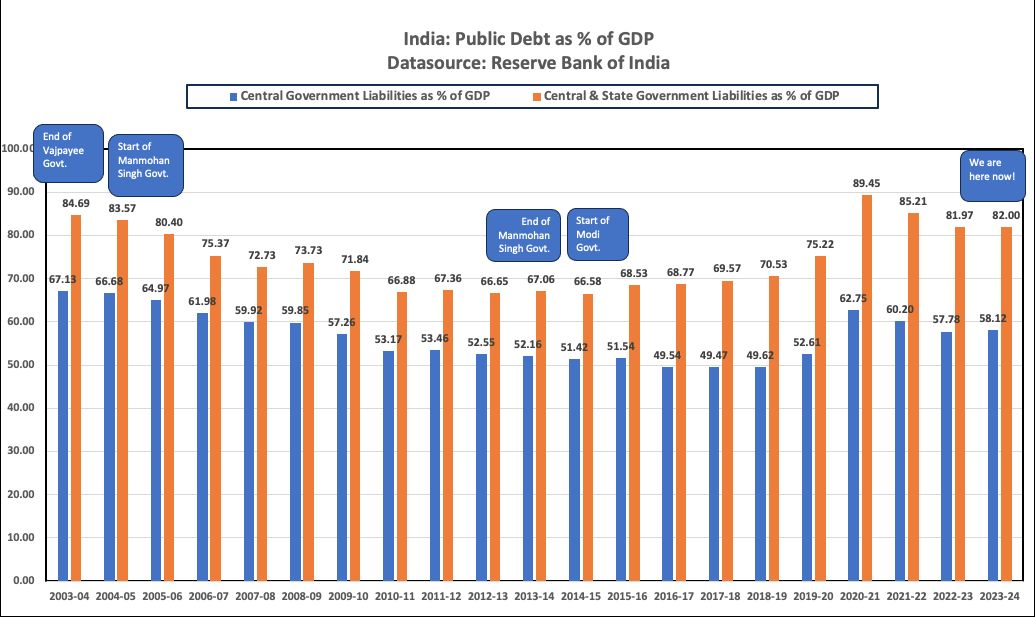Numbers Don't Lie: Public Debt Reduced in the UPA Era, Shot Up Under the Modi Govt
Union finance minister Nirmala Sitharaman released a "White Paper on the Indian Economy" on Thursday, February 8, which purportedly seeks to "generate a wider, more informed debate on the paramountcy of national interest and fiscal responsibility in matters of governance over political expediency".
The White Paper criticises the "mismanagement and short-sighted handling of the public finances during FY04-FY14", i.e. under the United Progressive Alliance (UPA) era.
However, official data shows that when the UPA-I government took charge in 2004, the gross debt of the Union government was over 67% of GDP and the gross debt of Union and state governments together (general government) was almost 85% of GDP.
When the UPA era ended in 2014, gross central government debt had come down to below 53% of GDP and general government debt to below 67%.
In the past 10 years under the Modi government, central government debt has climbed up to 58% of GDP in FY24 and general government debt to 82% of GDP.
Public Debt/GDP ratio declined during the UPA era because of two reasons:
1. GDP grew at a rate much faster than the previous regime.
2. Growth was driven by private investment, consumption, and exports allowing the government to maintain moderate fiscal deficits.

Public Debt/GDP ratio increased under the Modi regime because of two reasons:
1. GDP growth rate fell, first due to successive shocks like demonetisation, hasty introduction of GST, and finally the COVID-19 pandemic and lockdown
2. Growth has been over-dependent upon fiscal stimulus and the government's capital expenditure, with a slump in private investment and export growth
Unable to digest and acknowledge this simple fact, the Modi government has wasted the resources of the finance ministry to bring out election propaganda material ahead of the Lok Sabha elections, targeting the UPA government, which lost power 10 years ago.
Some of the criticisms made in the White Paper regarding the UPA era – like high inflation, high current account deficit, and bad debt accumulation of NPAs in public sector banks –are not entirely invalid. But the people voted them out 10 years ago, in 2014. What matters more today is the record of the past 10 years, from FY14 to FY24.
What has the Modi government done in the past 10 years? Both export and import growth have declined in the past decade, while the Indian rupee's value has fallen from Rs 60 per dollar in 2014 to Rs 83 per dollar today. Inflation has risen again in the past year, with food inflation currently touching the double-digit mark. Most disturbingly, over Rs 15 trillion of bank NPAs, mainly owed by large corporate defaulters, have been written off by the banks in the past 10 years.
Corporate tax rates have been cut down to historically low levels, affecting government revenues and widening the fiscal deficit. Yet, private investment has not taken off.
Unemployment levels are at historic highs. After betraying the aspirations of the youth, the Modi regime seeks to mislead them by relentlessly pursuing divisive policies in the name of religion.
What has prospered under the Modi regime is crony capitalism, with favoured corporate houses being showered with largesse to return their favour of funding the BJP through opaque channels like electoral bonds. The ongoing saga of the Adani group stands as a testimony. Rather than berating the governments of the past, the finance ministry would have done well to consider a White Paper on its own failures and deficiencies. That would have served the people better.
Prasenjit Bose is an economist and activist based in Kolkata.
This article went live on February ninth, two thousand twenty four, at zero minutes past seven in the evening.The Wire is now on WhatsApp. Follow our channel for sharp analysis and opinions on the latest developments.




